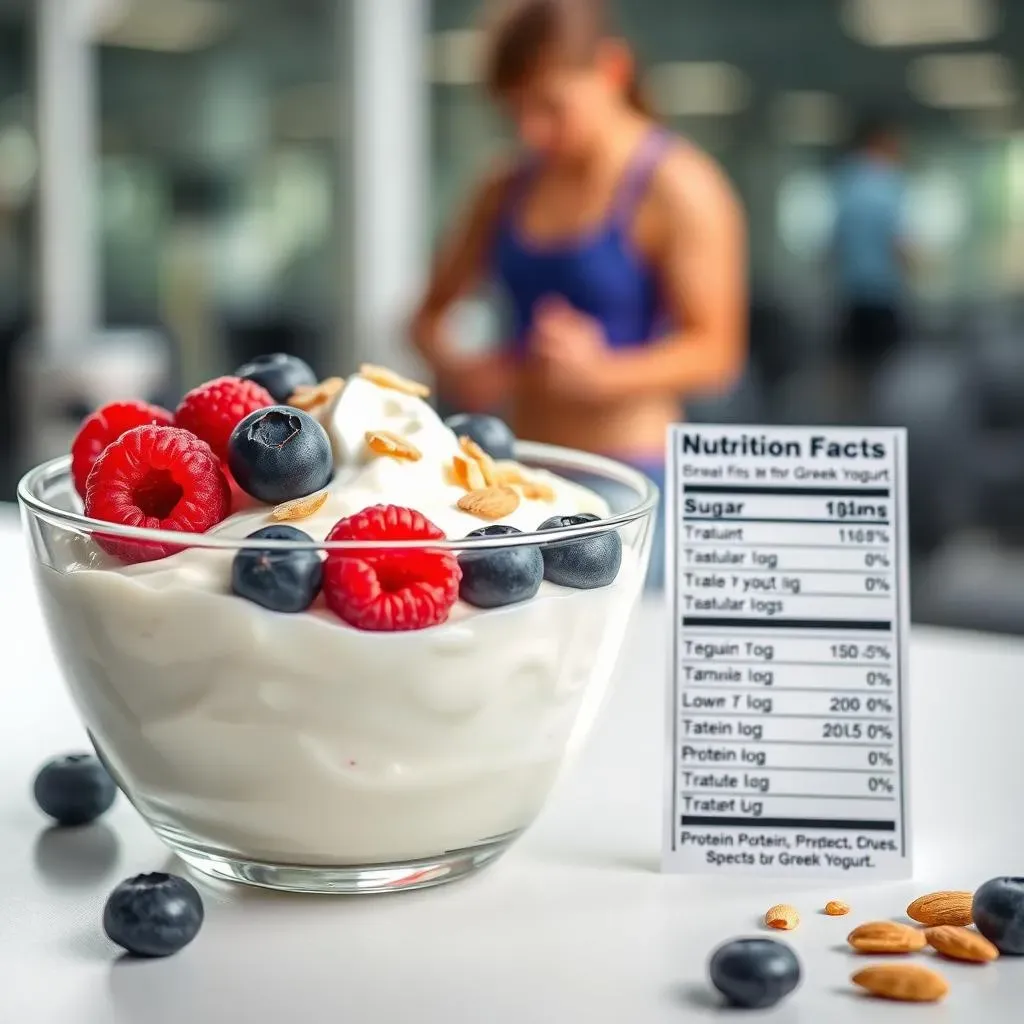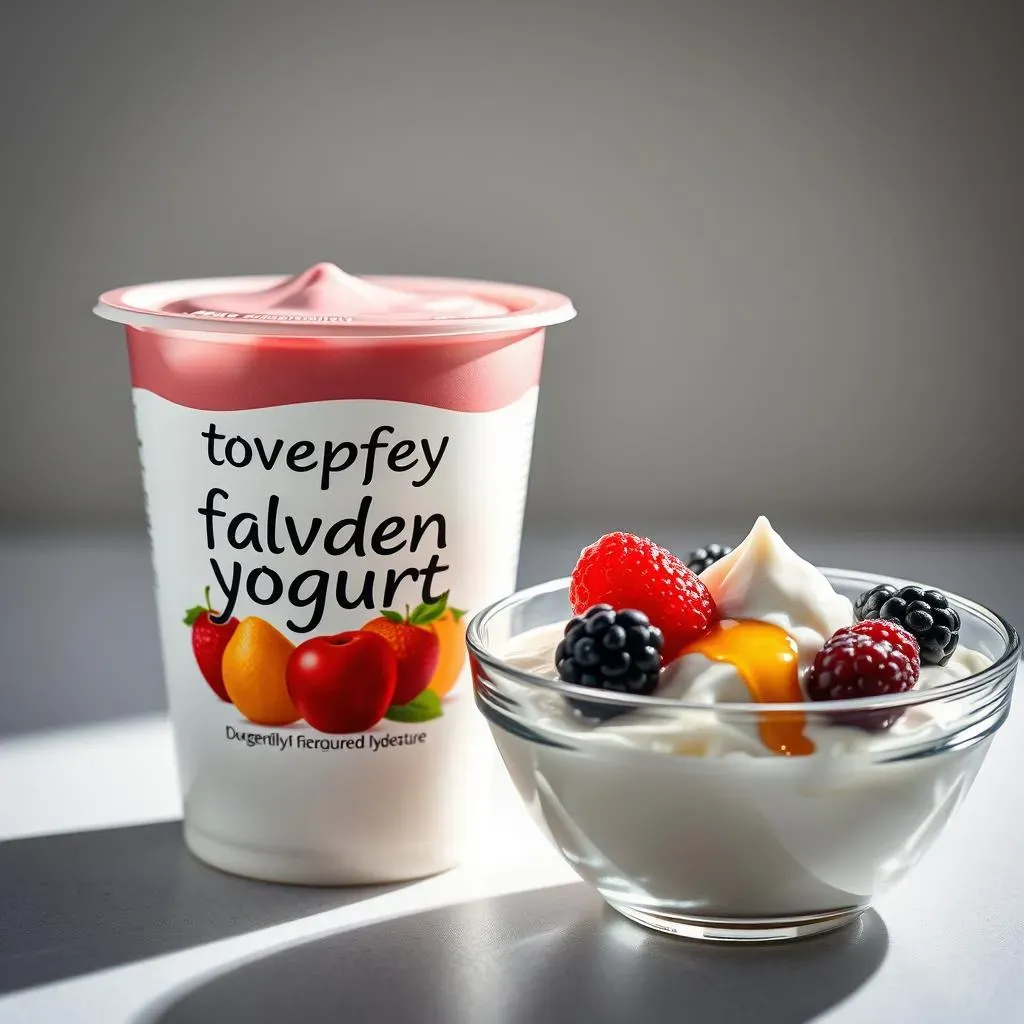Table of Contents
You're strolling down the yogurt aisle, trying to make a healthy choice. Low-fat options seem like a smart move, right? But have you ever stopped to wonder, does low fat yogurt have more sugar than its full-fat counterparts? It's a sneaky question that deserves a straight answer. Many people blindly assume that "low fat" automatically equals "healthy," but the reality can be a bit more complicated. Food manufacturers often compensate for the lack of fat by adding extra sugar to improve the taste and texture, turning your virtuous snack into a potential sugar bomb. This article will peel back the layers of yogurt labels, helping you navigate the confusing world of natural vs. added sugars. We'll compare low-fat and full-fat varieties, explore the unique benefits of Greek yogurt, and expose the hidden sugars lurking in flavored options. By the end, you'll be equipped with the knowledge to make informed decisions and choose yogurts that are truly good for you, without sacrificing taste or health. So, let's dive in and uncover the sweet truth about yogurt!
Decoding Yogurt Labels: Natural vs. Added Sugars

Decoding Yogurt Labels: Natural vs. Added Sugars
Understanding the Basics of Yogurt Labels
Alright, so you've got a yogurt container in your hand. First things first, flip it around and find the nutrition facts label. Don't be intimidated by all the numbers! The key thing we're focusing on here is the "Total Sugars" line. This number tells you the total amount of sugar in a serving of that yogurt, but it doesn't tell the whole story. You see, yogurt naturally contains lactose, which is a type of sugar found in milk. So, some of that "Total Sugars" number is actually naturally occurring.
The Difference Between Natural and Added Sugars
This is where things get interesting. The "Total Sugars" number on the label includes both the natural sugars (lactose) and any added sugars the manufacturer has put in to sweeten things up. Added sugars are the ones we need to watch out for, as they contribute empty calories and can lead to health problems if consumed in excess. Think of it like this: lactose is like the sugar that's already in an apple, while added sugar is like sprinkling extra sugar on top – totally unnecessary!
How to Spot Added Sugars on the Label
Unfortunately, it's not always super straightforward to figure out how much added sugar is in your yogurt. The FDA has made it mandatory to list "Added Sugars" separately on the nutrition label, but some older products might not have updated labels yet. In the meantime, a good rule of thumb is to look at the ingredients list. Common added sugars include sucrose (table sugar), high fructose corn syrup, honey, maple syrup, agave nectar, and fruit juice concentrate. If you see any of these ingredients listed, that means the yogurt contains added sugars. To get a rough estimate of the amount of added sugar, compare the "Total Sugars" to a plain, unsweetened yogurt of the same type. The difference is likely the added sugar content.
Yogurt Type | Total Sugars (per serving) | Likely Added Sugars (per serving) |
|---|---|---|
Plain Greek Yogurt | 5g | 0g |
Fruit-flavored Low-Fat Yogurt | 25g | 20g |
Low Fat Yogurt vs. Full Fat: A Sugar Showdown

Low Fat Yogurt vs. Full Fat: A Sugar Showdown
The Great Fat Debate: Is Low-Fat Always Better?
For years, we've been told that fat is the enemy. Low-fat products flooded the market, promising a path to weight loss and better health. But, like a plot twist in your favorite show, the science is evolving. Turns out, fat isn't the villain we thought it was. In fact, healthy fats are essential for hormone production, nutrient absorption, and overall well-being. So, when it comes to yogurt, choosing low-fat isn't always the slam-dunk decision we've been led to believe.
Why Low-Fat Yogurt Often Packs More Sugar
Here's the kicker: when manufacturers remove fat from yogurt, it can lose some of its flavor and creamy texture. To compensate, they often add sugar to make it more palatable. This is especially true for flavored yogurts, where the added sugar can be quite significant. So, while you might be saving a few calories from fat, you could be loading up on unnecessary sugar. It's like robbing Peter to pay Paul – not exactly a winning strategy!
Comparing Sugar Content: Low-Fat vs. Full-Fat Yogurt
Let's get down to specifics. To illustrate the potential sugar difference, consider these examples. A popular brand of plain, full-fat yogurt might contain around 7 grams of sugar per serving (all from natural lactose). Now, compare that to a fruit-flavored, low-fat version from the same brand, and you might see upwards of 20 grams of sugar! That's a huge difference, and most of that extra sugar is added. Always read the label and compare brands to make an informed choice. Your taste buds (and your waistline) will thank you.
Yogurt Type | Fat Content | Typical Sugar Content (per serving) |
|---|---|---|
Plain Full-Fat Yogurt | Full Fat | 7g (lactose) |
Plain Low-Fat Yogurt | Low Fat | 8g (lactose) |
Fruit-Flavored Low-Fat Yogurt | Low Fat | 20g+ (lactose + added sugar) |
Greek Yogurt: The ProteinPacked, Lower Sugar Option?

Greek Yogurt: The ProteinPacked, Lower Sugar Option?
The Greek Yogurt Advantage: Straining Away the Sugar
let's talk about Greek yogurt – the superhero of the yogurt world! What makes it so special? Well, Greek yogurt goes through an extra straining process that removes much of the whey, which is a liquid containing lactose (that natural milk sugar we talked about earlier). This straining not only gives Greek yogurt its signature thick and creamy texture but also reduces its overall sugar content. It's like magic, but it's actually just science!
Think of it this way: regular yogurt is like a smoothie, while Greek yogurt is like a super-concentrated protein shake. You get more of the good stuff (protein) and less of the stuff you might be trying to avoid (sugar).
Protein Powerhouse: Fueling Your Body the Right Way
Beyond its lower sugar content, Greek yogurt is also a fantastic source of protein. Protein is essential for building and repairing tissues, keeping you feeling full and satisfied, and supporting overall health. A single serving of Greek yogurt can pack a whopping 20 grams of protein or more, making it an excellent choice for breakfast, a post-workout snack, or even a healthy dessert. It's like giving your body a high-five from the inside out!
Navigating the Greek Yogurt Aisle: What to Look For
Now, before you go stocking up on Greek yogurt, there are a few things to keep in mind. Not all Greek yogurts are created equal. Some brands add sugar or artificial sweeteners to their products to enhance the flavor. So, it's essential to read the labels carefully and choose plain, unsweetened varieties whenever possible. You can always add your own healthy toppings, like fresh fruit, nuts, or a drizzle of honey, to customize the flavor to your liking. It's like being the master chef of your own yogurt creation!
Greek Yogurt Type | Protein (per serving) | Sugar (per serving) |
|---|---|---|
Plain, Unsweetened Greek Yogurt | 20g+ | 5-8g (lactose) |
Flavored Greek Yogurt (with added sugar) | 15-20g | 15g+ (lactose + added sugar) |
Greek Yogurt with Fruit on the Bottom | 15-20g | 20g+ (lactose + added sugar) |
The Hidden Sugars in Flavored Low Fat Yogurts

The Hidden Sugars in Flavored Low Fat Yogurts
The Allure of Flavored Yogurts: A Sweet Deception?
Let's be real – plain yogurt can be a bit, well, plain. That's why flavored yogurts are so tempting. They promise a burst of fruity goodness or a decadent dessert experience, all in a convenient little cup. But here's the catch: many flavored yogurts are loaded with added sugars, often in the form of high fructose corn syrup, sucrose, or fruit juice concentrates. These sugars can quickly turn a seemingly healthy snack into a sugar bomb, negating any potential benefits.
It's like that friend who always convinces you to order dessert, even though you're trying to eat healthy. Flavored yogurts can be sneaky like that!
Decoding the Flavors: Where Does All That Sugar Come From?
So, where does all that sugar come from? Well, it's a combination of factors. First, the added flavorings themselves often contain sugar. Think about it: fruit syrups, chocolate swirls, and caramel drizzles are all packed with sweetness. Second, manufacturers often add extra sugar to enhance the overall taste and texture of the yogurt, especially in low-fat varieties where the fat has been removed. This is because fat contributes to the creamy mouthfeel and richness of yogurt, and sugar is often used as a substitute.
Smart Swaps: Enjoying Flavor Without the Sugar Overload
Don't despair, flavor lovers! You don't have to give up flavored yogurt entirely. The key is to be a savvy shopper and make smart swaps. Opt for plain, unsweetened yogurt and add your own healthy toppings, like fresh fruit, berries, a sprinkle of nuts, or a drizzle of honey or maple syrup. This way, you have complete control over the amount of sugar you're adding. You can also look for brands that use natural sweeteners, like stevia or monk fruit, in moderation.
It's like being a DIY chef in your own kitchen – you get to create the perfect flavor combination without all the added junk!
Flavor Category | Typical Added Sugar (per serving) | Healthier Alternatives |
|---|---|---|
Fruity Flavors (strawberry, blueberry, etc.) | 15-25g | Plain yogurt with fresh berries and a drizzle of honey |
Dessert Flavors (chocolate, vanilla, caramel) | 20-30g+ | Plain yogurt with cocoa powder, a dash of vanilla extract, and a sprinkle of nuts |
"Healthy" Flavors (granola, honey, etc.) | 10-20g | Plain yogurt with a small amount of granola and a drizzle of honey or maple syrup |
Healthier Yogurt Choices: Finding the Sweet Spot

Healthier Yogurt Choices: Finding the Sweet Spot
Prioritizing Plain, Unsweetened Yogurt
Alright, let's talk strategy. The single best thing you can do for your health when it comes to yogurt is to choose plain, unsweetened varieties. Yes, they might not be as exciting as those brightly colored, fruit-filled cups, but trust me, your body will thank you. Plain yogurt gives you a blank canvas to work with, allowing you to control exactly what goes into your snack or meal. You can add your own healthy toppings, like fresh fruit, nuts, seeds, or a drizzle of honey, to create a customized flavor profile that's both delicious and nutritious. Think of it as becoming the artist of your own yogurt masterpiece!
Embracing Natural Sweeteners in Moderation
Speaking of sweeteners, if you need a little extra sweetness in your yogurt, opt for natural options like honey, maple syrup, or stevia. These sweeteners are generally considered to be better choices than refined sugars like high fructose corn syrup or sucrose. However, it's important to use them in moderation, as even natural sweeteners can contribute to excess calorie intake and blood sugar spikes. A little goes a long way! Think of it like adding a pinch of salt to a dish – it enhances the flavor without overpowering it.
Reading Labels Like a Pro: Key Things to Look For
Finally, become a label-reading ninja! Before you toss that yogurt into your cart, take a few seconds to scan the nutrition facts label and ingredients list. Look for yogurts that are low in added sugar, high in protein, and made with simple, wholesome ingredients. Avoid products that contain artificial sweeteners, artificial flavors, or excessive amounts of sodium. The fewer ingredients, the better! And remember, don't be fooled by marketing claims like "low-fat" or "all-natural" – always check the label to see what's really inside.
Label Element | What to Look For | Why It Matters |
|---|---|---|
Added Sugar | Less than 5g per serving | Minimizes empty calories and blood sugar spikes |
Protein | At least 10g per serving (Greek yogurt is ideal) | Promotes satiety and muscle building |
Ingredients List | Short and simple, with recognizable ingredients | Avoids artificial additives and unnecessary fillers |
The Final Scoop: Making Smart Yogurt Choices
So, does low fat yogurt have more sugar? The answer, as we've discovered, isn't always a simple yes or no. It depends on the brand, the flavor, and whether we're talking about natural or added sugars. The key takeaway is to become a savvy label reader. Don't be fooled by the "low fat" label; instead, focus on the total and added sugar content. Opt for plain, unsweetened varieties whenever possible and sweeten them yourself with fresh fruit and a touch of honey or maple syrup. By making informed choices, you can enjoy the creamy goodness of yogurt while keeping your sugar intake in check and truly benefiting your health.
